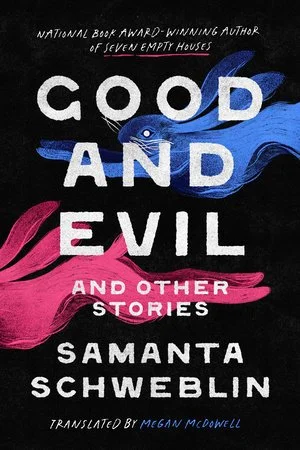Review: Good and Evil and Other Stories by Samanta Schweblin
Translated by Megan McDowell
Review by Andrea Avey
Knopf, 192 pages, $27, hardcover
Good and evil is one of many dualities humans utilize to make sense of the world. Binaries like this one tend to be easiest to reach for, but nothing about humanity and its civilizations can be so neatly categorized. In her latest short story collection, Good and Evil and Other Stories, Argentine writer Samanta Schweblin and her longtime translator from Spanish, Megan McDowell, prompt a closer examination of this dichotomy by creating characters, dilemmas, and circumstances that boldly defy absolutes to exist unabashedly in the grey.
Good and Evil marks the fifth book in this literary partnership, and readers can sense how the translation captures the alluring menace and palpable tension of Schweblin’s original Spanish to produce destabilizing yet engrossing psychological thrills. As McDowell notes in a recent interview in BOMB Magazine, the author’s tales “go to dark places but never lose their light touch.” This balance appears in the opening story, “Welcome to the Club,” which begins with a striking scene: the narrator in the act of drowning herself before ultimately relenting to resume her life as mother and wife. While underwater, she finds herself “surrendering to the fall as it grows softer, and to the colors all around me that seem new, denser, and more iridescent.” McDowell’s sentence adorns Schweblin’s unsettling scene with ease, grace, and a forbidden beauty. Even in this brief sentence, it’s evident the way McDowell embodies the contradiction at the heart of Schweblin’s work. McDowell chooses open sounds and sibilance in the first phrase before shifting to more closed, plosive sounds in the second—decisions that reflect both Schweblin’s sonic priorities in the Spanish (me entrego atenta a la caída que va suavizándose, a los tonos nuevos a mi alrededor, más densos y tornasolados.) and the thematic tension of experiencing awe or peace alongside terror or shock.
Schweblin’s collections often carry independent titles rather than adopt one of the story titles, and that’s true of Good and Evil and Other Stories as well. What fascinates me about the English title is how it separates “good” and “evil” as distinct—or at least not explicitly related—concepts, whereas the original Spanish, El buen mal, binds them grammatically with the adjective buen (good) modifying the word mal (bad). This reminds me of the subtleties at play in another relationship in Spanish: agridulce (bittersweet) and dulce y amargo (sweet and bitter). Bittersweet is its own particular flavor, but sweet and bitter connote both tastes in equal measure. At first blush, the translation is surprising in a collection concerned with extremes and their coexistence. Separating good and evil, or even just disentangling them, seems to disambiguate what the Spanish deliberately interweaves. However, the English refuses to articulate the relationship between them, a productive obscuring that supports their representation in the book. The translation forces readers to consider either end of the spectrum before firmly submerging them in its elusive in-between.
While each of Schweblin’s six stories is distinct, they are thematically linked. They draw the reader’s gaze to their connective ties of domesticity, fractured relationships, and bodies that do and do not perform as desired. When accessing long-ago memories, the narrator of “A Fabulous Animal” notices the primacy of physical details and speculates that pleasure and pain “always leave a more vivid sensation, because they’re things that happen in the body.” Schweblin’s collection is full of bodies—mostly women’s—that contort, withdraw, stretch, and malfunction.
The body is the site where emotional and physical truths collide with reality’s constraints. When a character from “William in the Window” perceives the presence of a recently deceased pet in her hotel room, she seeks physical companionship: “If I’m going crazy, I need someone to stay with me.” In “The Woman from Atlántida,” two young sisters habitually visit a stymied poet and masquerade as Inspiration, personifying the ephemeral and the fleeting. The narrator of the chilling last story, “A Visit from the Chief,” moves all her estranged daughter’s belongings with her into her new apartment, reserving physical space for an absented body. These examples point to the corporeal as a means of anchoring or transcending, even (and especially) when the surrounding world is uncanny or nightmarish.
Bodies betray and break, but they also mend and adapt. As humans, we are ambivalence embodied, capable of enacting and recognizing both beauty and horror. The experience of reading Samanta Schweblin is one where darkness conceals peril and enchantment alike.
-
Andrea Avey is a literary translator, writer, and dramaturg whose creative interests cluster at the intersections of identity, performance, memory, and art.

